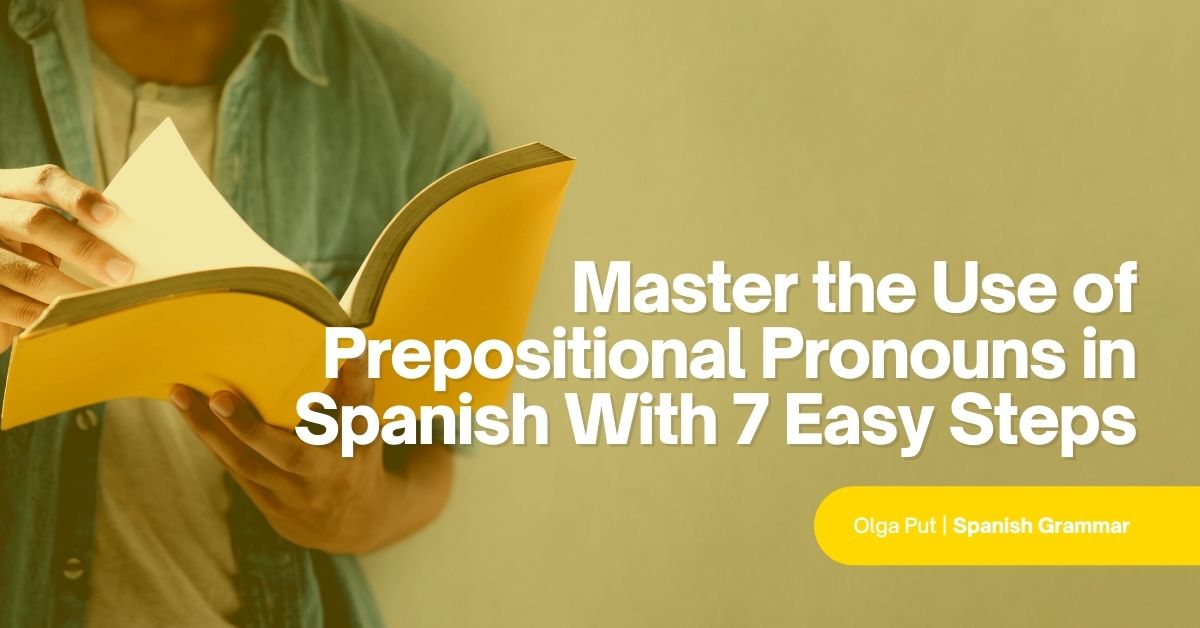
Conducir vs Manejar: What’s the Difference Between These Two Spanish Verbs?
Conducir and manejar are both used interchangeably in Spanish-speaking countries. However, they differ in meaning and use. Conducir and manejar mean “to drive,” among other things. Second-guessing which verb to choose is common. Yet, making the distinction is actually easier than you think! Even native speakers struggle in recognizing the difference. Join me in this blog post where I...Read More
A Comprehensive Guide To Spanish Adjectives
Learning Spanish adjectives at an early stage of your Spanish journey is key. When you’re a brand-new beginner, nouns and verbs are enough to survive and get your message through. However, if you want to express yourself fully in your new language, Spanish adjectives are what you need. Read this blog post to learn everything you need to know about Spanish adjectives at the...Read More
Master the Use of Prepositional Pronouns in Spanish With 7 Easy Steps
Prepositional pronouns in Spanish can be mastered with simple steps. To understand prepositional pronouns in Spanish, I provide you with the definition, forms, and many example sentences. You’ll also learn a few exceptions so that nothing can surprise you in the future. And last but not least, you’ll be able to see how much you’ve learned by taking the quiz at the end of the...Read More
Types of Spanish Words You Shouldn’t Capitalize
Spanish capitalization rules are sometimes surprising. Not all the words that are capitalized in English should be written in uppercase letters in Spanish, and vice versa. Learning capitalization rules is part of learning a new language. Read this article to learn about the capitalization rules in Spanish. In the end, test your knowledge with a pop quiz! Capitalization Rules in...Read More
How to Use Spanish Verbs with Prepositions ‘Con,’ ‘En,’ and ‘Por’
Spanish verbs with prepositions rarely resemble English verbs with prepositions combinations. They often have surprising translations that you would never suspect. To learn about this topic, a list of Spanish verbs with prepositions is not enough. I divided this post into logical sections that are easy to digest. You’ll also see many examples that will help you understand how Spanish...Read More
How to Form the Imperative Mood in Spanish
If you’ve ever taken a Spanish class, you’ve learned the imperative mood in Spanish right off the bat. You hear sentences in Spanish using the imperative mood from the first lesson. For example: Abran sus libros.Open your books. Repite, por favor.Repeat, please. Escuchen con atención.Listen carefully. Read this article to understand the grammar behind these sentences so that you...Read More
How To Write a Formal Letter in Spanish
Learning how to write a formal letter in Spanish is one of the most useful skills you can add to your professional toolbox. “Wait, are you saying that people still write letters?” Yes, and their importance is still as paramount now as ever before. For that reason, today I will review what a formal letter is, the differences between formal and informal letters, and the...Read More
Escuchar vs Oír: What’s the Difference Between These Two Spanish Verbs?
Escuchar and oir can be challenging verbs to master for Spanish learners. People tend to use both verbs to reference the art of hearing and listening. Both words are used interchangeably but have different meanings when you use them in practice. Even native speakers tend to confuse them with each other, which makes it difficult for Spanish learners who want to practice their...Read More
The Ultimate Guide to Filler Words in Spanish for More Natural Conversations
Learn about filler words in Spanish and improve your conversation skills! Filler words, palabras de relleno or muletillas, are words we use as a pause to imply we are not done speaking. They come in handy when we are hesitant or are trying to remember what to say. Feel free to use these filler words in Spanish as an opportunity to recover your train of thought in a foreign...Read More
